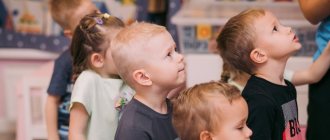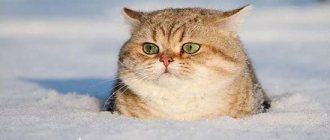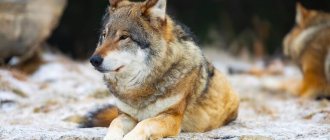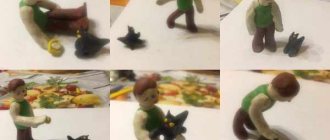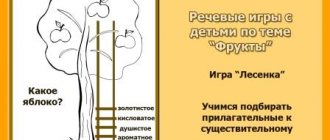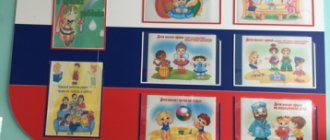All children love animals. Usually at the age of 6-8 years, a child begins to ask his parents to buy him a kitten, a puppy, a guinea pig, a hamster - anyone, just some kind of live animal, because children highly value communication with animals. But many adults see only problems in the appearance of a four-legged friend at home.
The possible manifestation of aggression on the part of the animal towards the baby and the need to constantly care for and clean up after the pet are frightening.
However, if you choose an animal that suits the child’s age, character and interests, then most unpleasant moments can be avoided.
The role of animals in the development of children
Pedagogical aspect
Children and dogs A pet is not only a source of warmth, affection and a friend, but also has a huge impact on the development of a child. Next to a four-legged friend, a child learns to be organized and disciplined. A pet teaches a child to be responsible for others. The child realizes that an animal is not a toy and needs to be looked after, fed, and walked every day. Communication skills with a pet will help a child in adulthood; he will learn to be responsible for his actions. Depending on the age of the child, the degree of responsibility in relation to the pet is determined.
So, at the age of 3 years, a child can walk a dog or cat with his parents, help pour out food, and make sure that the animal always has clean water to drink. A child of 7-9 years old can already be trusted to walk his small four-legged friend on his own. At 14-15 years old, a child can become the owner of an animal and bear most of the responsibility for it.
Social adaptation
The role of animals in the lives of children A four-legged friend for a child is the best psychologist and assistant in matters of social adaptation. Children who have a dog are easier than others to join a new team and make friends. A dog can help a shy child make contact with peers in the yard and find friends.
Neighboring children will definitely start asking about the animal, trying to play with it, and thus communication between the children will begin on its own. Walking a pet together can bring even the most taciturn children together.
Physical development
A pet contributes to the physical development of a child. When a child walks with a dog, plays ball with it, he is in constant motion, he develops proper coordination. In addition, communication with animals relieves stress and helps improve family relationships.
Intellectual development
A pet helps a child get to know the world around him. A four-legged friend is the source of the first knowledge about nature. The child observes the pet, its behavior, notes its reaction to stroking and various commands. The animal is also of great importance in the development of sensory perception in a child. Through the senses, the child perceives objects and learns to name them: shape, size, color, smell, movement, texture of fur, location, etc.
Communication with a pet also develops logical thinking. The child learns to see connections and dependencies. For example, if a cat stands by the bowl and meows, it means she is hungry; if a dog rushes to the door, jumps up and wags its tail, it means it wants to go for a walk. An animal is a source of various types of activities, as a result of which the child develops observation, curiosity, and develops imagination.
Moral development
An animal allows a child to experience his first experiences and joys. A four-legged friend gives rise to positive emotions, which is very important, because in the modern world it is precisely positive experiences that are most lacking. By interacting with a pet, a child develops a sense of beauty and learns to see natural beauty. The caring and caring attitude towards a pet that a child shows is transferred to him and the entire animal world as a whole.
If there is already an animal in the house
Many parents give their pet to friends or relatives for the first time after the birth of the baby, but this drastic measure can be completely avoided. You just need to accustom the animal to certain rules of behavior in advance and help it cope with stress. This is especially true for large pets - dogs and cats. It is easier to restrict access to the baby with a rat, rabbit, parrot or guinea pig - just make sure the cage is closed.
- Check how your pet reacts to sudden loud sounds: you can play a recording of a child’s cry on the computer. If the animal is afraid, comment on these sounds in a gentle and confident manner. You can also regularly turn on the baby mobile and make noise with a rattle, so that this does not come as a surprise to your pet;
- Start accustoming your pet to new smells. Let him into the room where the baby will sleep and let him sniff all the baby's things, especially all kinds of fragrant creams and lotions;
- Carefully consider the organization of space. If you don't want your pet to go into the nursery, train him to do so before giving birth. It is better to assemble furniture for your baby in advance so that your pet gets used to the rearrangement. Clearly define new boundaries for the animal: you cannot jump into a crib, climb under a stroller or cradle;
- Set up a quiet and peaceful place in the house where your pet can rest from the noise and chaos. His nervous system also needs to be rebooted!;
- If you know about any behavioral features of your animal that need to be corrected, contact a professional trainer or animal psychologist before the baby is born;
- Before being discharged from the hospital, pass some item of the baby's clothing home through relatives: by sniffing it, the animal will better adapt to changes.
When you return from the maternity hospital, be sure to pay attention to your pet, play with it a little, and say a few kind words. It is important for an animal, like a person, to understand that he is still loved. Don't hide the child, let him look at him and sniff the new family member. It is better to avoid very close contact, but there is also no need to completely separate the baby and pet: this will only increase jealousy. It is very important for dogs that their time spent outside is not reduced, so they will really enjoy walking together with a stroller.
Remember: the birth of a child is stressful for the animal, and its behavior may change slightly at first. But with your help, your pet will become your baby's best friend.
Which pet to choose for a child?
Child 3-4 years old
At this age, the baby actively explores the world around him. You can already have a pet, but adults will have to take care of it for now. For children 3-4 years old, it is better to have aquarium fish, a parrot, a hamster, a guinea pig or a rabbit. The child must first be told about the animal’s habits and characteristic features.
At first, the child will simply observe how the parents care for the pet, and then gradually become involved in the care process. It should be remembered that children are capable of showing their interest in living creatures in the most unexpected forms: taking a fish out of the aquarium to hold it in their hands, petting a bird, washing a hamster. Therefore, adults should always be careful and not allow children to perform such actions. It is necessary to explain to the child that this cannot be done, otherwise the pet may get sick.
Child 5-6 years old
At this age, the child's responsibilities for caring for a pet may expand. At 5-6 years old, you can already be trusted to wash the drinking bowls, pour the food yourself and pour water into the bowl. But for now, the child must do all this under the supervision of adults. For children of this age, you can get aquarium fish, birds, guinea pigs, rabbits, and hamsters.
Child 7-8 years old
Children at this age can take care of a pet almost independently. It will be very useful to read stories about animals, in which children can learn new information about the habits and characteristics of various representatives of the animal world. Adults should make it clear to children that animals need to be provided with conditions that are close to natural, and they need to be fed what they eat in nature. In order for a child to gain skills in caring for different animals and to make comparative observations of their behavior, you can get several pets, for example, a parrot and fish. At primary school age, a child can have the same animals as for earlier ages, as well as a dog or cat. But caring for four-legged animals should not yet be completely transferred to the child.
Topic of the week: “Pets”
Children should know:
- names of domestic animals: cow, cat, dog, goat, horse, pig, sheep, ram, horse; - names of cubs and family: calf, kitten, puppy, foal, lamb, piglet, kid; — the concept of “pets”; - the external signs of each, what they eat, how they voice; - where they live, what benefits they bring;
Expanding children's vocabulary:
Nouns : animal, horse, horse, foal, foals, cow, bull, calf, calves, sheep, ram, lamb, lambs, goat, goat, kid, kids, pig, hog, piglet, piglets, dog, dog, puppy, puppies, cat, cat, kitten, kittens, head, muzzle, ears, body, four paws (legs), horns, wool, tail, house, man, benefit, wool, meat, milk, leather, herd, farm, stable, hay, swill, horns, mane, hooves, barnyard, cowshed, kennel, booth, stable, pigsty, pasture, sheepfold, milkmaid, machine milking operator, pig farm, groom, shepherd, shepherd.
Adjectives : necessary, useful, kind, herbivorous, domestic, fluffy, smooth, horned, fierce, affectionate, evil, stubborn;
Verbs : start, feed, look after, protect, love, neigh, moo, bleat, meow, grunt, bark, meow.
Finger gymnastics “Burenushka”.
Give me milk, Buryonushka, (children show the cow’s “horns”, bend their index finger and little finger) At least a drop on the bottom. Kittens are waiting for me, little kids. Give them a spoonful of cream (they bend one finger at a time, starting with the little fingers, on both hands) A little cottage cheese, on both hands. Butter, curdled milk, milk for porridge. Cow's milk gives everyone health! (The cow’s “horns” are shown again)
Grammatical structure of speech
— Didactic exercise “One-many” (formation of plural nouns):
cat - cats - many cats foal - foals - many foals dog - dogs - many dogs kitten - kittens - many kittens pig - pigs - many pigs horse - horses - many horses
— Didactic exercise “Call it affectionately” (formation of nouns with diminutive suffixes in singular and plural):
cow - cow horse - horse cat - kitty sheep - sheep dog - dog sheep - sheep ram - lamb
— Didactic exercise “Count to five” (coordination of nouns with numerals):
One cat, two cats, three cats, four cats, five cats One cat, ..., five cats One dog, ..., five dogs One horse, ..., five horses One sheep, ..., five sheep One cow, two cows, three cows , four cows, five cows
— Didactic exercise “Guess who it is?” :
Guards, chews, barks? – the dog grunts, digs? - The pig neighs, runs, jumps? – Does the horse meow, lap, scratch? – cat Moos, chews, walks? - cow
— Didactic exercise “Who has who?” (word formation exercise):
Goat - goat - kids Cow - bull - calves Pig - boar - piglets Horse - horse - foals Dog - dog - puppies Sheep - ram - lambs Cat - cat - kittens Goat - goat - kids
— Didactic exercise “Who gives what voice?”:
The horse neighs. The sheep bleats. The dog barks and growls. The cat purrs and meows. The pig grunts. The cow moos.
— Didactic exercise “Whose? Whose? Whose?" (formation of possessive adjectives):
Dog kennel. - Whose kennel? - dog. Milk from goats, cows. - Whose milk? - goat, cow. Horns of ram, cow, goat. - Whose horns? - lamb, cow, goat. Tail of a horse, cat, dog. -Whose tail? - horse, cat, dog. Hooves of a cow, horse. -Whose hooves? - cows, horses. Goat beard. - Whose beard? - goat. Cat paws. -Whose paws? – feline.
— Didactic exercise “Who lives where?” (use of the nominative case of nouns):
lives in a barn (who?) - a cow lives in a pigsty (who?) - a pig lives in a kennel (who?) - a dog lives in a barn (who?) - a sheep, a ram lives in a barn (who?) - a goat
— Didactic exercise “Continue the sentences”:
The dog barks, gnaws bones, guards... (house). The horse neighs, grazes... (in the meadow). The cat purrs, catches mice... (in the basement).
— Didactic exercise “Correct the sentence”:
The dog cackles at strangers. — The dog barks at strangers. The cow gives wool. - The cow gives milk. The cat pecks at the milk. - The cat laps the milk. The pig growls in the trough. - The pig is splashing in the trough. The cat grunts on the sofa. – The cat is purring on the sofa.
— Didactic exercise Compose a story about a pet according to plan.
This is a goat, a domestic animal. The body is covered with fluffy hair. The head is small, elongated, with protruding horns. Loves green grass. Produces tasty meat, milk, wool. A goat lives in a barn, a stable.
Things to think about before getting a pet
First of all, you need to understand that you are getting a pet not only for your child, but also for yourself. If the child is still small, then most of the responsibilities for caring for the pet will fall on your shoulders. Think about whether you are ready to take on a new burden of responsibility and new worries. By getting an animal, you are getting a new family member who will require not only a lot of attention and time, but also certain financial expenses. It is also worth considering whether your living conditions allow you to have a pet.
If you live in your own home, you can have any animal. And in a small apartment, even fish may not find a suitable place. If you are still not ready to keep a pet, then it is better not to get one. Otherwise, when you decide to give the animal away, it can be a big tragedy for both the child and the pet.
Dangers from Pets
Animals can be dangerous to children. First of all, it's an allergy. If a child or someone in the house is prone to allergic reactions, it is not recommended to get an animal.
Also, many animals are carriers of various infections that a child can very easily catch. Therefore, if you get a pet, you need to periodically show it to the veterinarian and take the necessary tests. The danger can also come from large breed dogs. Such dogs are physically stronger than a child, so it is better not to have them.
It is also not recommended to have dogs with an unbalanced psyche. If you choose the right pet, take a responsible approach to raising it, and provide careful care, then all dangers can be minimized.
Weigh the pros and cons and choose the pet that is best for your child. Believe me, this will be the best gift for him! Good luck!
Consultation for parents “Our friends are animals”
Podgornaya Olga
Consultation for parents “Our friends are animals”
in the life of every parent when their child asks to buy a pet , usually cats or dogs. Of course, adults have a lot of excuses not to have a pet: it is necessary to get vaccinations, a lot of fur, germs, walk the pet, the parents can be understood, but the child - it’s necessary, but it’s worth thinking about whether it’s so bad if the baby is already ready to take care of someone else, and then, don’t forget how many advantages there are in this if you have a pet , the child is growing up, wants his life to be filled with something important, strive to help, to be useful, positive aspects are formed in the character, for example, qualities such as empathy, compassion and love, devotion, care, as well as the formation of activity in decision making by becoming a little more mature, a step - which implies responsibility, communication with an animal will also affect the qualities of character - it can become more open, attentive and friendly, feeling more significant in the pet’s life by showing care.
The appearance of an animal in the house will cause a storm of positive emotions in the child. After all, an animal for a child is, in fact, the same child with whom you can run, climb, play, and tell him your secrets.
As scientists have noted, the choice of animal depends on the type of person’s temperament and his particular needs, for example, cats help compensate a person’s need for physical contact, calmness and independence, dogs are the embodiment of live emotional contact, sociability, and a wonderful example of self-control. Therefore, it’s worth thinking about whether it’s so bad if you have a pet at home who will bring joy to your home and add a fresh direction in raising a child, for example, bring you closer to your baby, he will trust you more.
The most favorable age for owning a pet is 3-4 years . After all, it is at this age that a child actively learns about the world around him. Aquarium fish, parrots, rabbits or guinea pigs are animals that are most suitable for a child at this age. Introducing a child to a new family member must begin by showing the animal , you also need to talk about its characteristics, its habits, what the animal likes or, conversely , what it is afraid of. At first, all the worries about a pet will fall on the shoulders of adults, but gradually, watching how parents care for animals, the child will begin to get involved in the process.
Children are very eager to brush animals and feed them. However, here you need to be on guard so that the baby, for example, does not pour the entire box of food into the aquarium, or does not suffocate the rabbit while playing with it. The child must be under constant control, and if he does something wrong, it is necessary to correct his actions and explain why this should not be done.
The most important thing is that the child learns how to communicate properly with animals : not being pushy, being gentle. You need to teach your baby to feel the animal’s and react to it correctly.
By caring for this or that animal , children not only learn to feed it and clean up after it, but also learn a lot of new things from the life of this or that animal . Communication with pets instills kindness, affection, and warmth in children; the child develops the foundations of an ecological culture, which is an integral part of spiritual culture.
In addition, animals are a source of :
• child's knowledge about nature;
• sensory development;
• development of logical thinking. Children learn to see dependencies: if a cat wags its tail, it gets angry; if a dog sits near the door and whines, it wants to go for a walk;
•various types of activities: play, observation, work, etc.;
• joys and experiences;
• aesthetic development and education;
• labor education;
• physical development.
An animal in the house is not just a toy, but also a teacher, so if a child grows up with an animal , he gains invaluable experience of communicating with them and with others.
Children are sincerely and directly drawn to animals , and if you have noticed, this is mutual: cats and dogs are much more tolerant of children than adults. Unfortunately, it is not the children who decide whether to have pets or Therefore, if your child has a desire to have a pet and you have no compelling reasons not to do so (for example, an allergy of one of the family members), give in to him and buy your child a “friend”
.
After all, believe me, buying a pet has many more advantages than you think.

